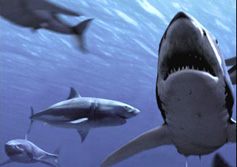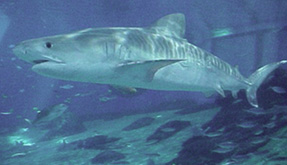 |
|
| Sharks |
 |
|
|
|
Sharks are one of the most ancient animals on earth, and one of the most misunderstood.
 People are sometimes killed by sharks, eaten alive. So some cultures have demonized them. But in Pacific island cultures, surrounded by the bountiful ocean, the shark was seen in a different light, for it was the shark that gave us Kuahupah. She was originally a fair-haired girl, who became a goddess when she married the shark god of the sea, arbitrating between shark and humanity, protecting both. For the last few decades, scientists and cameramen have been delving into their world. We think we know that a shark looks like. But beyond the image fixed in our mind, there are a lot we do not know. People are sometimes killed by sharks, eaten alive. So some cultures have demonized them. But in Pacific island cultures, surrounded by the bountiful ocean, the shark was seen in a different light, for it was the shark that gave us Kuahupah. She was originally a fair-haired girl, who became a goddess when she married the shark god of the sea, arbitrating between shark and humanity, protecting both. For the last few decades, scientists and cameramen have been delving into their world. We think we know that a shark looks like. But beyond the image fixed in our mind, there are a lot we do not know.
Most shallow water and bottom living sharks lay eggs, but open ocean sharks, like bonnet head, deliver live young—a method that first evolved in sharks, and has been passed in to mammals.
Perhaps sharks do have magical properties. They rarely suffer from cancer. Sharks liver oil contains 10 times more Vitamin A than cod-liver oil. Some shark skin has been found to contain a powerful antibiotic. The shark oil is even included in some lipsticks and other beauty products.
Shark’s skeleton is made entirely of cartilage. It’s lighter and more flexible than bone, giving the shark more speed and maneuverability. A shark swimming is grace itself. Streamlined bodies, positioning of the fins and shape of the tail enable it to master acceleration, cruising, and speed swimming. Human designers borrowed the shark’s hydrodynamics and applied it to submarines, and then took it to the air.
 Like man, most sharks are omnivorous, with a varied diet. The main reason a shark’s teeth remain so sharp is that they’re constantly being replaced. New teeth wait, row upon row, and move forward like a dental conveyor belt replacing those that are damaged and worn, and their entire skin is covered in tiny teeth, like chain mail. But some evidence suggests sharks don’t even like human flesh. In the 16th century, a sailor was swallowed whole then regurgitated live. From a shark’s point of view, a seal and a surfer look much the same. So sometimes mistakes are made. Like man, most sharks are omnivorous, with a varied diet. The main reason a shark’s teeth remain so sharp is that they’re constantly being replaced. New teeth wait, row upon row, and move forward like a dental conveyor belt replacing those that are damaged and worn, and their entire skin is covered in tiny teeth, like chain mail. But some evidence suggests sharks don’t even like human flesh. In the 16th century, a sailor was swallowed whole then regurgitated live. From a shark’s point of view, a seal and a surfer look much the same. So sometimes mistakes are made.
No human is a shark’s equal when it comes to its sensitivity to sound. They sense vibrations along their entire body, through tiny pores, directing them toward the prey before they even see it. Specially jelly-filled pores on the shark’s snout enable it to pick up the weakest of signals—even a heart beat. These electrical sensors guide them towards their prey. Despite our scientific advances, humans continue to fear and fight sharks.
译文:
鲨鱼是地球上最古老的动物之一, 也是被人误解最多的动物.
有时候, 鲨鱼会吃人, 甚至活活吞噬, 所以有些文化已把鲨鱼妖魔化. 然而在四面环海的太平洋岛屿文化中, 鲨鱼却被奉若神明, 因为鲨鱼为我们带来了库胡帕女神的传说. 她本是一位金发少女, 因嫁给海中的鲨神而成为女神, 她庇护着鲨鱼和人类, 并在两者之间调停斡旋. 在过去的几十年中, 科学家和摄影师们一直在探索鲨鱼的世界. 我们自以为了解鲨鱼, 但事实上他们与我们的成见相去甚远. 大多数潜水和深水鲨鱼都产卵. 但生活在开阔海域的鲨鱼, 如窄头双 鲨产幼崽. 这种繁衍的方式从鲨鱼开始, 并被哺乳动物所沿袭. 也许鲨鱼的确具有神性. 它们极少患癌症. 鲨鱼的肝油中维他命A含量是鳕鱼肝油中的10倍. 有的鲨鱼的皮内含有一种强力抗生素. 有些口红和美容产品中也含鲨鱼油.
鲨鱼的骨骼主要由软骨组成. 软骨比硬骨更轻, 更具柔性, 使鲨鱼的速度更快, 活动更灵敏. 鲨鱼游泳的姿势十分优美, 流线型的身躯, 鳍的定向作用和尾部的形状使它对提速, 漫游和快游得心应手. 人类设计家借用了鲨鱼的流体动力学原理, 并把它应用到潜艇的研制上, 后来还将它用于航空科技.
和人一样, 大多数鲨鱼属于杂食性动物, 吃各种杂食. 它们的牙齿很锋利, 主要原因在于, 它们不断地换牙, 新牙一排一排地陆续长出, 就像牙齿的传送带向前移动一样, 替换了磨损的旧牙. 而且它们的表皮布满了类似锁子甲的齿状鳞片. 但有证据表明, 鲨鱼并不喜欢食人肉. 在16世纪, 有个水手被鲨鱼活吞, 然后又被活着吐了出来. 在鲨鱼看来, 海豹和冲浪者没有什么区别. 所以有时就不免失误.
鲨鱼对声音的敏感程度无人能比. 通过细小的毛孔, 它们的整个身躯都感到震动波, 在看到猎物之前就循声前往捕捉. 鲨鱼吻部有一种充满胶质的特殊毛孔, 它能捕捉到为细弱的信号, 甚至是一声心跳. 这些电子传感器引导它们像猎物挺进. 尽管科学在不断进步,人类依然恐惧鲨鱼,并与之斗争。
|
|
|
|
|
|
|
|
 |



